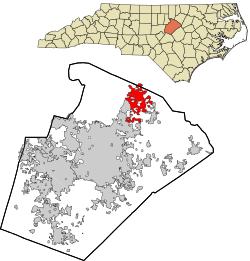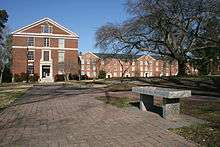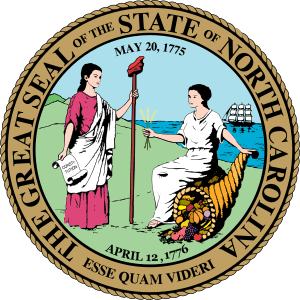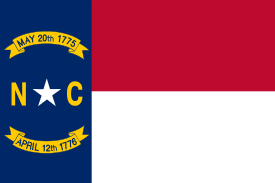Wake Forest, North Carolina
Wake Forest is a town in Franklin and Wake counties in the U.S. state of North Carolina; located almost entirely in Wake County, it lies just north of the state capital, Raleigh. The population was 30,117 at the 2010 census,[6] up from 12,588 at the 2000 census. The U.S. Census Bureau estimates the city's population to be 45,629 as of July 1, 2019.[7] In 2007, the town was listed by Forbes magazine as the 20th fastest growing suburb in America, with a 73.2 percent increase in population between 2000 and 2006.[8][9] Wake Forest was the original home of Wake Forest University for 122 years before it moved to Winston-Salem in 1956.
Wake Forest, North Carolina | |
|---|---|
 Location in Wake County and the state of North Carolina. | |
| Coordinates: 35°58′24″N 78°31′8″W | |
| Country | United States |
| State | North Carolina |
| Counties | Wake, Franklin |
| Incorporated | 1880 |
| Government | |
| • Mayor | Vivian A. Jones (D) |
| Area | |
| • Total | 17.84 sq mi (46.20 km2) |
| • Land | 17.71 sq mi (45.88 km2) |
| • Water | 0.12 sq mi (0.32 km2) |
| Elevation | 387 ft (118 m) |
| Population | |
| • Total | 30,117 |
| • Estimate (2019)[3] | 45,629 |
| • Density | 2,575.73/sq mi (994.52/km2) |
| Time zone | UTC−5 (Eastern (EST)) |
| • Summer (DST) | UTC−4 (EST) |
| ZIP Codes | 27587–27588 |
| Area code(s) | 919, 984 |
| FIPS code | 37-70540[4] |
| GNIS feature ID | 1023094[5] |
| Website | www.wakeforestnc.gov |
The US Office of Management and Budget also includes Wake Forest as a part of the Raleigh-Durham-Chapel Hill Combined Statistical Area, which has a population of 1,998,808 as of U.S. Census 2012 Population Estimates.[10] Effective June 6, 2003 the Office of Management and Budget redefined the Federal Statistical Areas and dismantled what had been for decades the Raleigh-Durham-Chapel Hill, MSA and split them into two separate MSAs even though the region still functions as a single metropolitan area.
History
In 1832,[11] Dr. Calvin Jones, originally from New England, bought 615 acres (2.49 km2) of forested land in Wake County, North Carolina. The sparsely populated area became known as the Forest of Wake, or Wake Forest. Jones sold his farm to the North Carolina Baptist Convention for $2,000, who opened the Wake Forest Manual Labor Institute, later Wake Forest College, on the site. The Raleigh & Gaston Railroad, completed in 1840, established a depot in nearby Forestville that stimulated the school and surrounding village. College leaders convinced the railroad to move the depot even closer to the college in 1874, leading to more economic development. This community was incorporated as the "Town of Wake Forest College" in 1880. In 1909, the word "College" was removed from the name of the town. The college moved to the much larger city of Winston-Salem in 1956.[12] Southeastern Baptist Theological Seminary began offering classes on the original campus of Wake Forest University in 1950, and occupied the entire campus when the university completed its move.
Government
Wake Forest operates under the council–manager form of government. The citizens elect a mayor and board of commissioners as the town's governing body. The town manager is appointed by the board to serve as the chief operating officer administering all municipal affairs.[13][14] The current mayor is Vivian A. Jones (R, term expires 2021) and the board of commissioners are James E. "Jim" Dyer (R, 2023), Elizabeth A. "Liz" Simpers (I, 2021), Chad D. Sary (R, 2023), Bridget L. Wall-Lennon (D, 2021), and Adam B. Wright (D, 2023).[15]
A new town hall facility opened in downtown Wake Forest in September 2010,[16] and was LEED Platinum certified in November 2011.[17] All town departments are housed in the facility, except police (which has its own building nearby) and public works.
Geography
Wake Forest is located at 35°58′24″N 78°31′8″W (35.973289, -78.518789).[18]
According to the United States Census Bureau, the town has a total area of 15.2 square miles (39.4 km2). 15.1 square miles (39.1 km2) of it is land and 0.1 square miles (0.3 km2) of it (0.80%) is water.[19]
Wake Forest is located in the northeast central region of North Carolina, where the North American Piedmont and Atlantic Coastal Plain regions meet. This area is known as the "Fall Line" because it marks the elevation inland at which waterfalls begin to appear in creeks and rivers. Its central Piedmont location situates Wake Forest about three hours by car west of Atlantic Beach, North Carolina, and four hours east of the Great Smoky Mountains.
Climate
Wake Forest enjoys a moderate subtropical climate, with moderate temperatures in the spring, fall, and winter. Summers are typically hot with high humidity. Winter highs generally range in the low 50s °F (10 to 13 °C) with lows in the low-to-mid 30s °F (-2 to 2 °C), although an occasional 60 °F (15 °C) or warmer winter day is not uncommon. Spring and fall days usually reach the low-to-mid 70s °F (low 20s °C), with lows at night in the lower 50s °F (10 to 14 °C). Summer daytime highs often reach the upper 80s to low 90s °F (29 to 35 °C). The rainiest months are July and August.
Demographics
| Historical population | |||
|---|---|---|---|
| Census | Pop. | %± | |
| 1880 | 456 | — | |
| 1890 | 858 | 88.2% | |
| 1900 | 823 | −4.1% | |
| 1910 | 1,443 | 75.3% | |
| 1920 | 1,425 | −1.2% | |
| 1930 | 1,536 | 7.8% | |
| 1940 | 1,562 | 1.7% | |
| 1950 | 3,704 | 137.1% | |
| 1960 | 2,664 | −28.1% | |
| 1970 | 3,148 | 18.2% | |
| 1980 | 3,780 | 20.1% | |
| 1990 | 5,769 | 52.6% | |
| 2000 | 12,588 | 118.2% | |
| 2010 | 30,117 | 139.3% | |
| Est. 2019 | 45,629 | [3] | 51.5% |
| U.S. Decennial Census 2018 Estimate[20] | |||
As of the 2000 census,[4] there were 12,588 people, 4,617 households, and 3,407 families residing in Wake Forest. The population density was 1,614.4 inhabitants per square mile (623.1/km²). There were 5,091 housing units at an average density of 652.9 per square mile (252.0/km²). The racial makeup of the town was 79.63% White, 15.78% African American, 0.21% Native American, 2.03% Asian, 0.01% Pacific Islander, 0.78% from other races, and 1.56% from two or more races. Hispanic or Latino of any race were 2.08% of the population.
There were 4,617 households out of which 41.7% had children under the age of 18 living with them, 60.3% were married couples living together, 10.7% had a female householder with no husband present, and 26.2% were non-families. 20.6% of all households were made up of individuals and 6.0% had someone living alone who was 65 years of age or older. The average household size was 2.66 and the average family size was 3.11.
In the town, the population was spread out with 29.7% under the age of 18, 7.4% from 18 to 24, 39.3% from 25 to 44, 15.8% from 45 to 64, and 7.9% who were 65 years of age or older. The median age was 32 years. For every 100 females, there were 91.8 males. For every 100 females age 18 and over, there were 89.0 males.
The median income for a household in the town was $52,307, and the median income for a family was $60,408. Males had a median income of $45,630 versus $30,205 for females. The per capita income for the town was $22,746. About 6.3% of families and 8.8% of the population were below the poverty line, including 10.7% of those under age 18 and 15.7% of those age 65 or over.
Education
Primary and secondary education
The town is served by nine public schools which are administered by the Wake County Public School System. Public schools include:
- Heritage Elementary School
- Jones Dairy Elementary School
- Wake Forest Elementary School
- Richland Creek Elementary School (opened August 2012)
- Heritage Middle School
- Wake Forest Middle School
- Heritage High School (Wake Forest, North Carolina) (opened August 2010)
- Wake Forest High School
Charter schools include Franklin Academy (K-12),Wake Forest Charter Academy (K-8), Endeavor Charter School (K-8), and Envision Science Academy (K-8). Private schools include Thales Academy, All Saints Academy, and St. Catherine of Siena Catholic School, serving grades K-8.[21] Wake Forest is also home to two Montessori schools, Wake Forest Montessori[22] and Montessori Children's House of Wake Forest.

Higher learning
Wake Technical Community College [23] is an area two-year college with a north campus on Louisburg Road in Raleigh. Southeastern Baptist Theological Seminary is a seminary of the Southern Baptist Convention. It began offering classes in 1950 on the original campus of Wake Forest University and is commonly known by its acronym, SEBTS.
Culture
Performing arts
Wake Forest hosts the annual Wake Forest Dance Festival every fall at E. Carroll Joyner Park.
Historical locations
The DuBois Center is listed on the National Register of Historic Places.[24] The W. E. B. DuBois School opened in 1926 for the African-American community in Wake Forest before racial segregation ceased in 1971. After the school outgrew the facility and moved to a new location, the building was vacant for a decade until the DuBois Alumni Association purchased the building and made it into a community center.[25]
Other listings in or near Wake Forest on the National Register of Historic Places are the Bailey-Estes House, Downtown Wake Forest Historic District, Glen Royall Mill Village Historic District, Lea Laboratory, Oakforest, Powell House, Purefoy-Chappell House and Outbuildings, Purefoy-Dunn Plantation, Rock Cliff Farm, Royall Cotton Mill Commissary, South Brick House, Thompson House, Wake Forest Historic District, Wakefield Dairy Complex, and Wakefields.[26][27][28]
Wake Forest Historical Museum, also known as the Calvin Jones Historical House, was built in 1820 and was the residence of the first president of Wake Forest College and the center of activities that took place at the school. The museum displays the history of the town of Wake Forest as well as Wake Forest University. The house contains collections of photos, books, college publications, furniture, documents, professors’ writings, and medical, law and sports memorabilia.[29]
Library
The Wake County Public Library System operates a branch in Wake Forest.[30]
Parks and recreation
Wake Forest is home to the Falls Lake State Recreation Area. Falls Lake Park contains the 12,000-acre (49 km2) Falls Lake and 26,000 acres (110 km2) of woodlands.[31]
Wake Forest is served by ten parks and community centers. They include the following:[32]
- Plummer Park
- Joyner Park
- Tyler Run Park
- Holding Park and Wake Forest Community House
- J.B. Flaherty Park
- Taylor Street Park and Alston Massenburg Center
- Ailey Young Park
- H.L. Miller Park
- Kiwanis Park
- Smith Creek Soccer Center
Transportation
Passenger
- Air: Wake Forest is served by Raleigh-Durham International Airport, which is located 20 miles (32 km) southwest of the town in northwestern Wake County.
- Interstate Highway: Wake Forest can be accessed by I-85 and I-40. The town is located to the east of I-85 and north of I-40.
- Wake Forest is not served directly by passenger trains. Amtrak serves nearby Raleigh.
- Local bus: The Triangle Transit Authority operates buses that serve the region and connect to municipal bus systems in Raleigh, Durham, and Chapel Hill.
Roads
- Wake Forest is located off US 1 (also known as Capital Boulevard in northern Wake County), a major north-south U.S. Highway that serves the East Coast of the United States.
- Other highways that run through the area include NC 96 and NC 98.
Media
Magazine
- 27587 MAGAZINE -- "A North Carolina Original" is a glossy metro led by a group of creative journalists and honored by the North Carolina Press Association. The quarterly magazine, which debuted in 2014, has the "longest shelf life" given its original stories and photography and is distributed free in the Raleigh-Durham-Wake Forest region at new-home developments, professional offices, points of interest, supermarkets, RDU airport, and via direct mail. Full issues may be read at 27587magazine.com (there is a lag of several weeks before the current issue is released online).
On air
Newspaper
- The town's independently-owned community newspaper, The Wake Weekly, has an average circulation of more than 8,400 copies per week.[33]
Online only
References
- "2019 U.S. Gazetteer Files". United States Census Bureau. Retrieved July 27, 2020.
- "2010 Census Redistricting Data (Public Law 94-171) Summary File". American FactFinder. United States Census Bureau. Retrieved 27 May 2012.
- "Population and Housing Unit Estimates". United States Census Bureau. May 24, 2020. Retrieved May 27, 2020.
- "U.S. Census website". United States Census Bureau. Retrieved 2008-01-31.
- "US Board on Geographic Names". United States Geological Survey. 2007-10-25. Retrieved 2008-01-31.
- "Profile of General Population and Housing Characteristics: 2010 Demographic Profile Data (DP-1): Wake Forest town, North Carolina". United States Census Bureau. Retrieved December 30, 2011.
- "Population and Housing Unit Estimates". Retrieved May 21, 2020.
- WRAL. "3 Area Towns Among Fastest-Growing Suburbs :: WRAL.com". wral.com. Retrieved 3 April 2018.
- "America's Fastest-Growing Suburbs - Forbes.com". 2008-02-20. Archived from the original on 2008-02-20. Retrieved 2017-07-11.
- "Population Estimates 2012 Combined Statistical Areas: April 1, 2010 to July 1, 2012". U.S. Census Bureau. Retrieved 2013-03-14.
- "History - Town of Wake Forest, NC". www.wakeforestnc.gov. Retrieved 3 April 2018.
- "History - Wake Forest, NC". wakeforestnc.gov. Retrieved 3 April 2018.
- "Mayor - Wake Forest, NC". www.wakeforestnc.gov. Retrieved 3 April 2018.
- "Board of Commissioners - Wake Forest, NC". www.wakeforestnc.gov. Retrieved 3 April 2018.
- "Board Members - Town of Wake Forest, NC". www.wakeforestnc.gov. Retrieved 2018-02-28.
- "Town Hall - Town of Wake Forest". Retrieved 8 October 2014.
- "LEED Platinum Certification - Town of Wake Forest". Retrieved 8 October 2014.
- "US Gazetteer files: 2010, 2000, and 1990". United States Census Bureau. 2011-02-12. Retrieved 2011-04-23.
- "Geographic Identifiers: 2010 Demographic Profile Data (G001): Wake Forest town, North Carolina". United States Census Bureau. Retrieved December 30, 2011.
- "Population Estimates". United States Census Bureau. Retrieved June 8, 2018.
- "schools in Wake Forest - YELLOWPAGES.COM". yellowpages.com. Retrieved 3 April 2018.
- "- YELLOWPAGES.COM". Retrieved 8 October 2014.
- Wake Technical Community College/
- "Area Attractions - Wake Forest, NC". wakeforestnc.gov. Retrieved 3 April 2018.
- "DuBois". wcpss.net. Retrieved 3 April 2018.
- "National Register Information System". National Register of Historic Places. National Park Service. July 9, 2010.
- "National Register of Historic Places Listings". Weekly List of Actions Taken on Properties: 12/27/10 through 12/30/10. National Park Service. 2011-01-07.
- "National Register of Historic Places Listings". Weekly List of Actions Taken on Properties: 5/26/14 through 5/30/14. National Park Service. 2014-06-06.
- "ギャンブルよりも、やっぱり風俗なんだよなぁ". www.wakeforestbirthplace.org. Retrieved 3 April 2018.
- "WakeGOV: Page Not Found". www.wakegov.com. Retrieved 3 April 2018.
- "Falls Lake State Recreation Area - NC State Parks". ncparks.gov. Retrieved 3 April 2018.
- "Parks & Facilities - Wake Forest, NC". wakeforestnc.gov. Retrieved 3 April 2018.
- "The Wake Weekly". www.wakeweekly.com. Retrieved 3 April 2018.
- "Wake Forest News - Entertaining Wake Forest with news since 2013". Wake Forest News. Retrieved 8 October 2014.
- "Wake Forest Today - The Community's First Digital Daily News Source". Wake Forest News - From Wake Forest North Carolina and surrounding community. Retrieved 8 October 2014.


